Phil Bildner's Blog
May 25, 2020
A School Canceled My Virtual Author Visit Because of A HIGH FIVE FOR GLENN BURKE
Photo Illustration by The Daily Beast
A school canceled my virtual author visit because they didn���t want their fourth graders to know about my middle grade novel A High Five for Glenn Burke. They didn���t want their fourth graders to know about it because they feared a few loud parents in their community.
The book is about a boy who loves baseball, karaoke, and the movie The Sandlot. Realizing he���s gay, the boy does a school report on Glenn Burke, the gay Major League Baseball player who was erased from sports history because of who he was. It���s a novel about acceptance and living one���s authentic life.
When I found out the school canceled my visit, I was crushed. I wanted to put everyone on blast and name names — the principal, the superintendent, the members of the parents��� association. I wanted to post an open letter to the community because they needed to know that decisions were being made that weren���t in the best interest of their kids.
But I didn���t. I didn���t even though I said I would the next time this happened. I didn���t because it wouldn���t have been in the best interest of the kids living in that community.
I was supposed to visit the elementary school back in March, but the visit was canceled because of COVID-19. The school circled back after the scheduled date and said they wanted to convert my in-person visit into a virtual one. We set the new date for May 14th.
On Friday May 8th, the parents��� association informed me that the principal wanted to see the presentations I’d be sharing with the students. I forwarded them. They���re the presentations I���ve shared with elementary school kids dozens and dozens of times around the country.
On Sunday May 10th, A High Five for Glenn Burke was reviewed in the print edition of the New York Times. To say I was thrilled to have my book featured in the Sunday Book Review is the understatement of the year. Here���s the link to the digital version.
The next day, the parents��� association informed me I wasn���t permitted to mention A High Five for Glenn Burke to the fourth graders. I asked for an explanation and requested that the principal email me. The principal would not. The principal would only speak on the phone. A few hours later, I received an email from the president of the parents��� association informing me my visit was canceled.
I knew what this was. I knew exactly what this was. I���d seen it before. It had happened to me before, and sadly, it will happen again. Educators making bigoted and morally bankrupt decisions at the expense of their students because they fear a handful of parents in their community.
That���s what happened here. The school knows it, too: Their absurdly worded emails. The school administrator ��� almost certainly on the advice of counsel ��� unwilling to create additional digital imprints. The parent organization running interference for the school administration. The additional absurdly worded emails setting up specific members of the parents��� association (unbeknownst to them) to be the fall guys and scapegoats. It���s conduct straight out of the censorship playbook.
Of course, if called out, the school will deny it and try to tell another story. That���s what comes next. It always does. They���ll try to confuse the chronology, spin a contrived narrative, and gaslight the community into believing an alternate reality. They���ll do this even with the knowledge that their own emails, texts, and statements contradict and undermine their false claims. All that is straight out of the censorship playbook, too.
In A High Five for Glenn Burke, the main character is realizing he���s gay. Just like some of the fourth graders at that elementary school. I wanted to tell those fourth graders that in a few months when they���re in intermediate school, they should look for the book in their library. In intermediate and middle school, those kids will be trying to figure out who they are and where they fit in. I wanted them to know this book exists because they need to know books like this exist.
It is the duty of schools and educators to accept and protect all kids, not pick and choose which ones to accept and protect. When schools and educators knowingly opt to deny the existence of some of its students, it���s beyond educational malpractice. It���s cruel. It is the moral imperative of schools and educators to respect the humanity of every single one of their kids.
Every single one — black kids, brown kids, Jewish kids, immigrants, girls, Muslim kids, Asian kids, queer kids.
Everyone.
Last week, I filed a report with the American Library Association Office for Intellectual Freedom. I drafted my open letter. Shared it with several author friends. Shared it with my publisher.
But the more I sat with it, the more I realized an open letter to this community was not in the best interest of their kids.
Shortly after A High Five for Glenn Burke came out, Pernille Ripp, a middle school educator and the creator of the Global Read Aloud, posted a review. In it, she wrote:
���So I write this post ���for us, the adults, in the lives of these children to understand just how much it matters for our kids to be seen. How much they hope to be represented in our libraries, in our classrooms, in our curriculum, in our teaching staff. That some kids don���t get to be accepted at home so they hope that school is the place where they will be. That some kids face hatred before they come into our rooms and hope that with us they will be accepted for whoever they are, wherever they are on their journey. And they hope but it doesn���t always happen and soon they learn to hide that part of themselves, because it is safer to live half-hidden than be known for all that they are.���
Some kids are hated at home, and yes, it���s as horrible as it sounds. And it���s exponentially worse right now because some of those kids are quarantining in unsafe and even dangerous environments.
We know how this school truly feels about its students. They may say they care about all of them, but their actions say otherwise. They do not stand up for all their kids. Some are ignored and erased. And during this moment of pandemic learning, it���s even easier for the school to ignore and erase those kids. Make like they don���t even exist.
My heart aches for the queer kids in this community, especially the ones sheltering in place in toxic homes. I didn���t want to pile on the harm. I didn���t want to risk making their lives even the slightest bit more difficult. And when in-person schools reopen, we know they���ll be returning to a hostile and unsafe space. I didn���t want to exacerbate their situation.
So then why say anything at all?
Because people need to know this kind of bigotry and hatred continues to happen, bigotry and hatred aimed at kids. People need to hear about it. It needs to be out in the open.
Educators who fear parents to the point of knowingly making decisions that are not in the best interest of all children have no business teaching children. Educators who let a handful of loud parents dictate school policy at the expense of the children they���re entrusted to protect are no better than those bully parents. Educators who are afraid to stand up for all their kids are bullies.
Every single kid matters. Everyone is appropriate. No one is controversial. Everyone has the right to exist.
Everyone.
March 6, 2020
When Bully Parents Cancel An Author Visit
[image error]I had a school visit cancelled this week.
No, not because of the novel coronavirus. The school would not allow me to speak to its middle school students — middle school students — about A High Five for Glenn Burke, my new middle grade novel. The school would not allow me to speak to the kids about any LGBTQ themes.
In preparation for my visit, the school was working with a local bookseller. A pre-order form was sent out to families so that students could purchase books. Some parents ��� lunatic parents, the school���s words, not mine — learned about A High Five for Glenn Burke and complained to the school.
No, these parents did not read the book. Nor did they want their children reading the book. Nor did they want their children or any children at the school being exposed to LGBTQ themes.
The principal didn���t stand up to the parents. The principal didn���t stand up for her students. The principal didn���t stand up for her community. The principal let the bully parents dictate policy. The principal let the bullies win.
The school is in Long Island, New York. It���s a Catholic school ��� an accepting and progressive Catholic school, the school���s words again, not mine. The school knows and acknowledges it has LGBTQ students. The school claims to support all of its students.
But saying you���re accepting and progressive, and saying you support all your students is one thing. Being accepting and progressive, and actually supporting all your students is another.
When you erase LGBTQ books and eliminate access to them, you are not being accepting and progressive. You are not supporting all your students. When you erase LGBTQ lives and stories, you are not being accepting and progressive. You are not supporting all your students. You are engaging in censorship, and worse, you are abandoning your moral responsibility. You have not just allowed the bullies to win, you have allied with the bullies. You have become the very thing you said you were against.
I had a school visit cancelled this week.
[image error]For months now, I���ve been discussing this insidious form of censorship and erasure with K.A. Holt, the author of the middle grade novel Redwood and Ponytail. She���s also had schools cancel her appearances when cowardly administrators have failed to stand up to the loud bullies in the community, when cowardly administrators have pledged fealty to the bully parents. Kari Anne has helped me find the language to speak on this issue.
Educators, administrators, school boards, and parents talk a lot about kindness and empathy. They talk about how to teach it and model it. But too often, when it comes to our LGBTQ students, it���s just talk.
That���s not acceptable. Because lives are at stake. Children���s lives are at stake.
When books are kept from kids because of close-minded and fear-driven adults, and when individuals are erased because of close-minded and fear-driven adults, what we���re really teaching and modeling is that people without empathy prevail, and that kindness only matters when it’s shown to certain people and defined by a loud few.
Trust me, our LGBTQ kids hear this message loud and clear. And when that message comes from the adults they trust, it moves beyond bullying to cruelty.
When A High Five for Glenn Burke came out in February, Pernille Ripp, an educator and the creator of the Global Read Aloud, wrote a beautiful review. But in that review, it���s almost as if she knew some schools would try to erase this book and LGBTQ kids:
So I write this post to not just highlight the incredible masterpiece that is Phil Bildner���s new book, but for us, the adults, in the lives of these children to understand just how much it matters for our kids to be seen. How much they hope to be represented in our libraries, in our classrooms, in our curriculum, in our teaching staff. That some kids don���t get to be accepted at home so they hope that school is the place where they will be. That some kids face hatred before they come into our rooms and hope that with us they will be accepted for whoever they are, wherever they are on their journey. And they hope but it doesn���t always happen and soon they learn to hide that part of themselves, because it is safer to live half-hidden than be known for all that they are.
I had a school visit cancelled this week.
We had a signed contract in place for more than six months. The opening paragraph ��� the opening line — of the signed contract reads:
“WHEREAS, the Sponsor is familiar with the Author and the work of the Author and requests that the Author personally visit the Sponsor to enhance the opportunities for its students…���
In terms of the presentations, the signed contract reads:
���The focus of the presentations shall be the Author���s process, the Author���s books, the Author���s life, and other related topics.���
The school knew I was openly gay. The school knew about my books. The school knew about A High Five for Glenn Burke and that I���d be talking about it with the middle schoolers. The school visited my website, read my social media posts, and watched my videos. The school knew what I shared at my author appearances.
The school acknowledged and admitted they were breaching the terms of the signed contract. The school paid me not to show up. They paid me not to speak to the students.
They paid me to go away, to erase me.
It���s scary for schools to stand up to the bully parents. The bully parents are loud and say hateful things. They���re driven by fear and ignorance. And standing up isn���t just scary, it���s often risky. Sometimes jobs and livelihoods are on the line.
But when a school allows the ugly and loud voices to be valued over its own students, the school fails its students. When the interests of the misinformed and fear-driven bully parents outweigh the life-changing and often life-saving needs of its students, their experiences, and their existence, the school has failed.
This week, this school taught its LGBTQ students that their stories are not valid, right, or appropriate. They taught its students with LGBTQ family members and LGBTQ friends that the stories of their loved ones are not valid, right, or appropriate. This week, this school taught all its students that LGBTQ lives are not worth as much. Their lives and their stories are worth less. As a child, when you internalize the message that your story ��� your existence ��� is worth less, you begin to believe and understand you are worthless.
My heart aches for the LGBTQ kids at this school.
My heart aches for all the kids at this school.
My heart aches for the cowards who accept erasure as an answer.
[image error]
February 13, 2020
A High Five For Dad, A High Five For Glenn Burke
A High Five For Dad, A High Five For Glenn Burke
My dad will never read my new middle grade novel, A High Five for Glenn Burke. Even if he does, he won’t remember it. He has dementia.
I said goodbye to my dad last summer on July 16. Well, I said goodbye to a version of Dad because I knew the next time I saw him – in a week, or two weeks, or a month – there was a chance he wouldn’t know who I was.
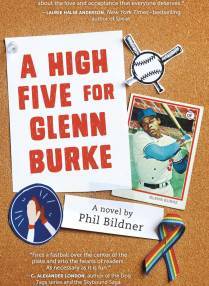
A week earlier, the medication he was taking to slow the progression of the insidious disease stopped working. The blockers holding in place his card catalog of life gave way, scattering his memories. The deterioration was sudden and shocking.
Devastating.
If not for my dad, I could have never written A High Five for Glenn Burke. He is responsible for my love of baseball.
Dad grew up a Brooklyn Dodgers fan. He used to tell me stories about Pee Wee Reese, Duke Snider, and Jackie Robinson and how he would go to Elsie Day Games at old Ebbets Field.

We bonded over baseball. We bonded over the New York Mets.
He took me to my first game on April 20, 1974. It was the first Saturday after tax season. Dad was an accountant and worked Saturdays during tax season. Then again, he worked every day during tax season, and tax season seemed to get longer and longer and longer every year.
The game that day didn’t start until two-fifteen, but I needed to be at Shea Stadium before noon. I didn’t want to miss a thing. We walked up the ramps to our seats, and when that field appeared before me for the first time, it looked nothing like the baseball fields I’d seen on the Zenith in our family room. This field was so big and so green, a field of dreams.
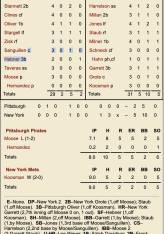
We sat in the mezzanine that afternoon. The Mets won 5-2. Jerry Koosman tossed a complete game five-hitter. Wayne Garrett belted a home run. We called him “Wayne Street” Garrett because we lived on Wayne Street.
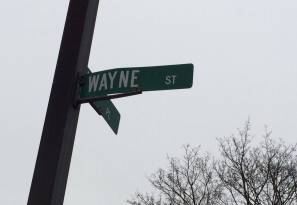
My dad and I played catch on Wayne Street. He threw me grounders that I fielded like Buddy Harrelson and Doug Flynn. I caught his pop flies like Del Unser and Steve Henderson. I practiced pitching like I was Craig Swan and Tom Seaver.
We never used a hardball, only a tennis ball. The neighbors always parked their cars in the street, and I’d learned the hard way that baseballs and windows don’t get along.
On weeknights, I’d sit on the steps and wait for his car to turn up Wayne Street, hoping there’d be time for an after-work catch before the sun dipped behind the houses. Daylight Saving Time was my favorite time of year.
On weekends, I’d walk into his study, glove in hand, to find out when he could take a break and “come up for air.” That’s what he called it. Some days I waited hours. All days it was worth the wait.
I started playing little league in second grade. It was called the instructional league. My dad was one of my coaches, but that was the only year he could manage it because of work.
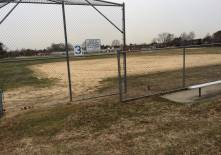
I played little league all through elementary school. He tried to make my weekday practices and games, often showing up in his suit straight from work. On the nights he couldn’t, I’d wait on the front steps for his car to turn up Wayne Street. Then I’d sit at the kitchen table while he ate his dinner and tell him all about baseball.
On weekends, games started at one and four-fifteen. It was tough for him to make the early games on Saturdays, but he always made the later ones. He made the Sunday games no matter what time they started.
The games meant so much more when he was there.
Every year, we went to several Mets games.
One of my dad’s clients had a six-seat box in the loge. A couple times each season, we got to sit in it. Three seats in the first row, three seats in the second between home and third. My seat was always first row on the aisle, and I’d sit with my glove dangling over the railing because I was going to catch a foul ball.

In the ninth inning on June 1, 1976, Richie Hebner fouled off Bob Myrick’s pitch right into my dad’s outstretched hand.
That ball sits on a shelf in my office. That ball was in reach of my outstretched hand while I wrote A High Five for Glenn Burke.
My dad took me to my first opening day in 1981. The Mets beat the Cardinals on a freezing cold April 15, Tax Day. He ducked out of work early just so we could go.
I started going to every opening day, though I went with friends because weekday matinees during the first and second week of April didn’t work for Dad.
I went to dozens of games with my friends in the eighties. We’d drive to Flushing, park on College Point Boulevard, stop at my friend’s deli for heroes, and then walk across the Roosevelt Avenue Bridge to Shea. We’d buy tickets in the upper deck, and then over the course of the game, we’d sneak down to the mezzanine and loge. After the seventh, we’d wait outside the field level gates and ask the men in suits leaving early for their ticket stubs. Then we’d watch the rest of the game from our box seats.
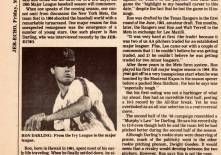
One year, I contacted Jay Horwitz, the Mets’ legendary Public Relations Director. I wrote for my high school newspaper, and in the front offices at Shea Stadium, I got to interview my favorite Mets player of all, Ron Darling.
I didn’t go to opening day in 1986, the most amazin’ year in the history of the team. I was in North Shore Hospital that day. Growing up, I had a secret. I considered it a demon, a demon I was going to defeat. Because this demon couldn’t be me. It couldn’t be who I really was. It ate away at me, tormented me, and tortured me to the point where teenage me wanted to end his life.
The first time I ever saw my dad cry was opening day in 1986.
I came out to my dad ten years later on July 24, 1996. He was sitting at the kitchen table in the house where I grew up on Wayne Street when I told him. He was sitting in the seat where I used to watch him eat dinner while I told him all about baseball.
It was the second time I ever saw him cry.

After that day, Dad never flinched. After I told him I was gay, he never flinched. Not once, not ever.
A few years later, we went to a game at Shea and sat first row in the field level boxes. My boyfriend, Kevin, who later became my husband, went too. It was the day David Wright made his debut for the New York Mets.
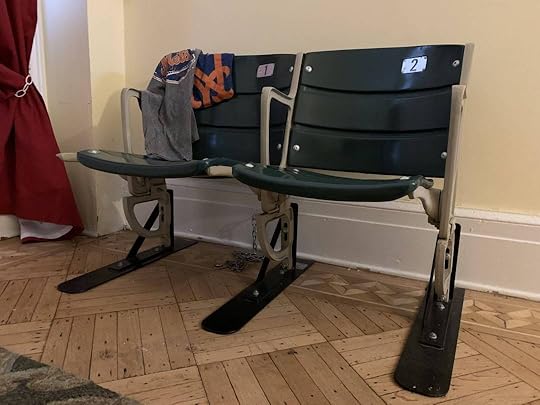
Before Shea Stadium was torn down after the 2008 season, season ticket holders were given the opportunity to purchase their seats. A friend had season tickets for seats that I sat in a few times each year. He wasn’t buying his seats, so I did. I bought a pair of seats from the mezzanine. Like the seats I sat in with my dad the first time we ever went to Shea.
When Kevin and I lived in our Brooklyn loft, we kept those seats by the front door. Here in Newburgh, they’re by the front door, too. Whenever my dad visited, he always sat in them when he took off his sneakers before coming in and when he put them back on before heading out.
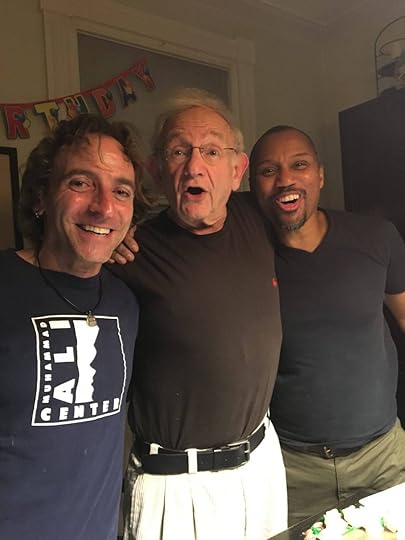
After saying goodbye to my dad last summer. I sat in my car in the driveway of his home on Vista Drive – he no longer lived on Wayne Street — and wrote in my journal. I needed to get down my thoughts and his last words.
As I wrote, the Dave Matthews Band version of Neil Young’s “Cortez the Killer” played in the background. The next day, I looked up the lyrics. The last line is, “I still can’t remember when or how I lost my way.” The song isn’t about memory, but it is for me. That song will always be about those eleven words.
My dad may not be able to remember, but I still can. I know how much baseball meant to him. I know how much baseball meant to us. I also know how much I meant to him.

My dad would have loved A High Five for Glenn Burke. No, it’s not a book about fathers and sons and baseball. But it is a book about love and truth and baseball. He would’ve understood its importance. More than anyone. It’s a book I never could have written if not for William Bildner.
High five, Dad.
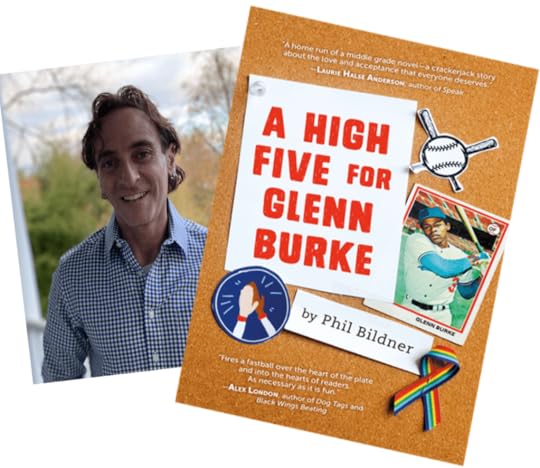
“A home run of a middle grade novel―a crackerjack story about the love and acceptance that everyone deserves.” ―Laurie Halse Anderson, author of Speak
“Fires a fastball over the center of the plate and into the hearts of readers. As necessary as it is fun.” ―C. Alexander London, author of the Dog Tags series and the Skybound Saga
“Silas is a realistic middle-grade hero―a baseball-obsessed kid trying to find his place in the world. Readers will love him, just as I do.” ―Erin Entrada Kelly, Newbery Medal-winning author of Hello, Universe
A HIGH FIVE FOR GLENN BURKE is Phil Bildner’s most personal novel yet. Order your copy of this important middle grade novel today. Available where books are sold February 25, 2020.
December 11, 2019
A High Five For Andrew Clements
A High Five For Andrew Clements
Thank you, Andrew Clements.
Like thousands of other classroom teachers over the past twenty plus years, I shared the novel Frindle by Andrew Clements with my students. In class 6-413 at the West Farms School in the Bronx in the fall of 1997, it was one of our “read-alouds.” It was a joyous and memorable shared learning experience. Over the years, millions and millions of young people around the globe have read Frindle.
For those of you not familiar with the book, it���s the story of a fifth-grade boy named Nick, who ��� much to the chagrin of his seemingly uptight teacher, Ms. Granger ��� comes up with a new name for a pen. He calls it a frindle. Nick���s new word quickly spreads around the classroom… and then the entire school… and before he knows it ��� in present-day terms ��� the word goes viral.
Frindle is arguably one of the most beloved middle-grade novels of a generation.
[image error]
frin��dle /��frindl/ noun
a pen; an instrument for writing or drawing with ink
the title of a novel written by Andrew Clements and illustrated by Brian Selznick
Back in early 2018, when Wes Adams (my editor at Farrar, Straus, and Giroux), was about to acquire my middle grade novel, A High Five for Glenn Burke, I sent an email to my agent, Erin Murphy. The subject line of the email was ���So When.��� The opening sentence of the email read:
So when Wes and FSG decide to buy A HIGH FIVE FOR GLENN BURKE, I’m going to write a blog post called, “Frindling.”
Later that Spring, I met with Wes in the old FSG offices in the Flatiron Building. We discussed the manuscript and some of the plans for the book. I mentioned that I intended to write a series of blog posts around the time of publication. One of those posts would be called ���Frindl-ing.���
Then this past August, when I sat down with the publicity and marketing teams at Macmillan, we talked about the launch of A High Five for Glenn Burke. We discussed plans for a blog tour. My ���Frindl-ing��� post would be part of it.
But when I learned that Andrew Clements passed away over the Thanksgiving holiday, I felt I needed to write my post now.
[image error]
Prior to penning (pun intended) Frindle, Andrew Clements had only written picture books. In fact, when Andrew first wrote Frindle, it was a three-page picture book, not a one-hundred-and-five-page middle-grade novel. And it wasn���t called Frindle. It was called Nick’s New Word.
For six months, Andrew shopped the manuscript to different publishing houses. As he wrote on his website:
And during the next six months as I sent the three-page picture book story to five different editors at five different publishing companies, they all told me basically the same thing: ���It needs to be longer, don���t you think? It would be so much better as a chapter book.���
Andrew listened to those editors. He re-wrote the picture book as a novel and shopped the manuscript to four different houses. He received four rejections.
Finally, the manuscript ended up on the desk of legendary editor, Stephanie Lurie at Simon & Schuster.
A book ��� and a word ��� was born.
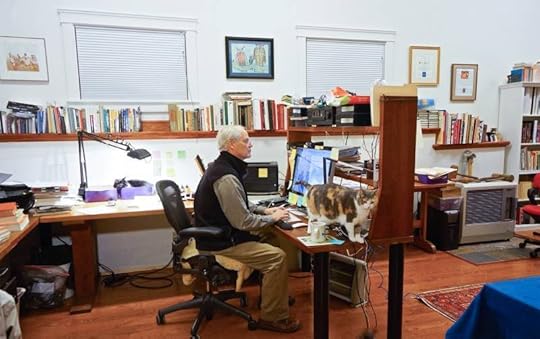
[image error]One of my favorite documentary series is ESPN���s 30 for 30, which showcases memorable sports moments and individuals. In 2014, they released the short film High Five. It told the origin story of the universally known celebratory gesture. I was familiar with some of the history behind the high-five (but not all), and after watching the documentary, I recall thinking: “there’s a picture book in here somewhere.”
But at the time, I was busy writing the first two books in my Rip & Red series. A picture book ��� if there was a picture book in there ��� would have to wait.
A little over two years later, in late 2016, I returned to the high-five picture book idea. As I researched the topic, I felt the best approach would be to write the story as a biography of Glenn Burke.
Glenn Burke was the Major League Baseball player in the 1970s who created the high five. Rising through the ranks of the Los Angeles Dodgers farm system, he was a highly regarded prospect who some thought could be the next Willie Mays.
Unfortunately, Glenn Burke was run out of baseball because he was gay. Then in the 1980s, his life took several tragic turns, and like so many others, he died way too young from AIDS.
It took me more than a few drafts to write the story, but by the end of year, I���d completed the picture book manuscript of A High Five for Glenn Burke.
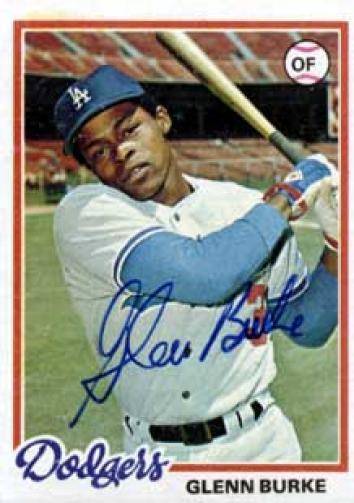
In January of 2018, Erin shared the manuscript (along with a number of other project proposals) with Wes. Several weeks later, we heard back. The opening line of his email:
I’ve read, pondered, discussed, and pondered some more these projects, and am coming back with a response that I know will be somewhat unexpected.
After addressing the other projects, Wes focused on A High Five for Glenn Burke:
As a picture book, I don’t see it. The genre doesn’t seem the right zone to fully explore his story, which is largely confined to the afterword. The age level seems wrong for grappling with even the challenges he was up against as an openly gay player.
Among the many reasons why I love working with Wes is that often times he���s able to see things that others don���t. That���s certainly the case when it comes to my storytelling and writing. And it was definitely the case here. Wes didn���t see this as a picture book. He envisioned it as something else:
Instead, here’s the book we would love to see: A HIGH FIVE FOR GLEN[N] BURKE. Being a MG fiction that’s upbeat and humorous but also impactful and filled with heart about a present day baseball loving kid���
A book was born.
I even said so in the acknowledgements.
Wes Adams, my editor. Thank you for your unparalleled vision, guidance, and wisdom. You saw a middle grade novel on the pages of a picture-book manuscript and patiently worked with me as I��Frindle-d the text
I���d learned years ago from my husband, Kevin Lewis, that Frindle had been a picture book before it was ever a middle-grade novel. Kevin worked as an editor with (and was hired by) Stephanie Lurie at Simon & Schuster. In fact, if you look at Brian Selznick���s illustration in The Janitor���s Boy, that���s Kevin right there in the middle with many others from the back-in-the-day Simon & Schuster Books for Young Readers team.
When I talk about the writing process and the importance of revision with kids, I love sharing the Frindle backstory. And now I love that I���m going to be able to share another layer to the Frindle tale.
For me, a frindle now has another meaning. It���s no longer just another name for a pen or the name of a book. A frindle is a middle-grade novel ��� or perhaps any novel ��� that started out as a picture book.
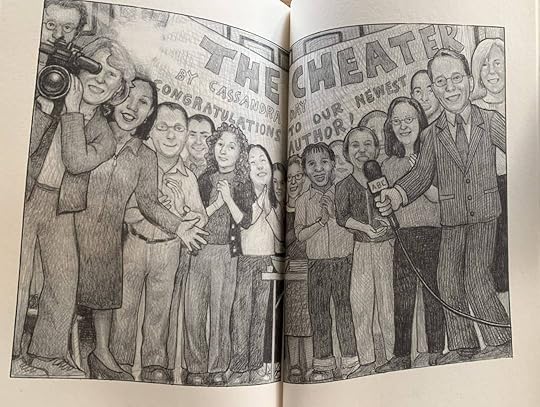
frin��dle /��frindl/
noun: frindle
a picture book that was converted into a middle-grade novel
verb: frindling
the act of converting a picture book manuscript into a middle-grade novel
Andrew, thank you for gifting the world��Frindle.
��
Thank you for�� The Landry News ,�� Lunch Money ,�� No Talking ,�� The Losers Club , and all your books.
��
We miss you already.
��
High five, Andrew. High five!
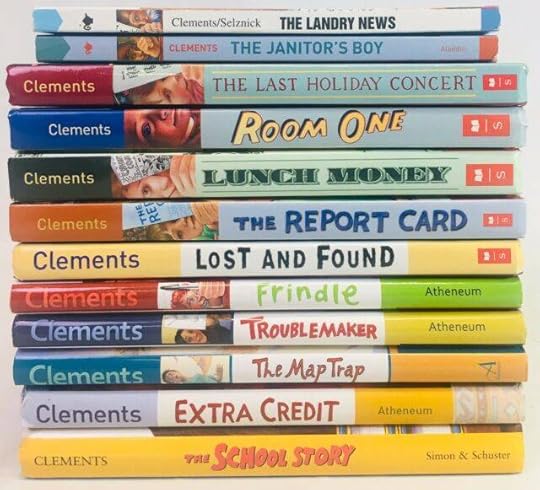

���A home run of a middle grade novel���a crackerjack story about the love and acceptance that everyone deserves.��� ���Laurie Halse Anderson, author of Speak
���Fires a fastball over the center of the plate and into the hearts of readers. As necessary as it is fun.��� ���C. Alexander London, author of the Dog Tags series and the Skybound Saga
���Silas is a realistic middle-grade hero���a baseball-obsessed kid trying to find his place in the world. Readers will love him, just as I do.��� ���Erin Entrada Kelly, Newbery Medal-winning author of Hello, Universe
A HIGH FIVE FOR GLENN BURKE is Phil Bildner’s most personal novel yet. Order your copy of this important middle grade novel today. Available where books are sold February 25, 2020.
November 28, 2017
Make This Year the Year of the Author Visit
Every student deserves to experience an author visit. It doesn’t matter if they attend a rural Title I school in York County, Nebraska or an elite prep school on the Upper West Side of New York City, every student should have the opportunity to experience an author visit.
So let’s make this year the year of the author visit!
Why Bring in an Author?
Why bring an author to your school?
The value of an author visit can’t be overstated. Author visits are impactful and inspirational. They touch the lives of students. They open minds and hearts. They even alter the course and change the trajectory of lives.[image error]
But make no mistake, when an author visits a school, it has to be the right author. Just because someone writes beautiful books doesn’t mean they have any business standing in front of a room full of students. When an author visits a school, it may very well be the first and only time many of those students ever get to meet and interact with an author. It is the responsibility – the moral obligation – of that author to convey the critical importance of reading, writing, the arts, and life.
That is the right author. That is the author all students deserve to hear in their own school.
Money
Author visits cost. Authors get paid to visit schools. Many authors earn a significant portion of their income from school visits and appearances fees.
At first glance, the cost of an author visit may seem prohibitive. But in reality, they’re inexpensive, especially when you consider the long-term return on the investment. The per-child cost of an author visit is somewhere between the cost of a Happy Meal and a matinee movie ticket. Often, that’s less than the cost of an all-school field trip.
So consider an author visit an in-school field trip, a school-wide celebration of reading, writing, the arts, and life. That’s a worthwhile investment.
Free Author Visits
What about all those schools that get free author visits? Why should we pay when others don’t?
Yes, there are schools that get free author visits. Sometimes an author has a personal connection with a school and will donate a visit. Other times, a school has a relationship with a local bookstore that in turn, has a relationship with a publisher or publicist. If an author is traveling on a publisher-sponsored tour, the tour may include school visits, and yes, those visits are free. These schools are fortunate beyond words, but in reality, there are very, very few of these schools.
We Can’t Afford an Author Visit
Yes, you can afford an author visit.
I’m a former middle school teacher in the New York City Public Schools. I understand slashed budgets and limited resources. But schools that truly want their students to experience an author visit find ways to make it happen.[image error]
How do they do it?
Some schools have set aside activity funds. The dream scenario is when these activity funds have a line-item budget allocation for author visits, but sadly, those don’t exist in most places. In schools where there is an activity fund, the administrators and money distributors need to make author visits a priority.
Some schools rely on the generosity of a PTO or a parent organization. If your PTO or parent group does not sponsor an author visit, perhaps they’re unaware of their significance and importance. Attend one of their meetings. Help them understand why author visits should be a priority.
More and more schools rely on Title I funds to pay for author visits. Yes, Title I funds can be used to pay for author visits. When an author visit is linked to the curriculum (and it should be), Title I funds can be used. The visit isn’t taking away from or interfering with the instructional day. It’s enhancing student learning. It’s complementing literacy programs, and history programs and social studies programs and civics programs. It’s reinforcing writing process lessons. Unfortunately, many schools – many administrators – don’t know this. They need to know this.
Some schools use the proceeds from book fairs to pay for author visits. Some reach out to local businesses and have them sponsor the visit. Some schools hold penny or change drives to fund a portion of the visit. In those instances, the students are literally investing in and taking ownership of the author visit. Some schools write grants (there are many available). Some schools have taken to Donorschoose.org.
Schools find ways to make author visits happen.
Why Not Skype?
Why not just Skype with an author? Why not just host a virtual author visit?
By all means, Skype with an author. Host a virtual author visit. But this isn’t a binary decision. Just because you Skype with an author doesn’t mean you shouldn’t bring an author to your school. While Skype visits can be (and should be) rich and rewarding, nothing compares to the in-person author visit. For many students, it’s like having their favorite pop star or sports hero come to their school.
The value of that is immeasurable.
But We’ve Never Hosted an Author Visited
If you’ve never hosted an author visit, even the idea of one can seem daunting and intimidating.
But hosting an author visit doesn’t require reinventing the wheel. There are incredible resources out there to help you through the process. Check out some of the posts on the Nerdy Book Club site (use the tag, author visits). Check out the News on The Booking Biz site (use the tag, Author Visit Tips). Visit individual author websites. Reach out to your PLN (personal learning network) on Twitter. Reach out to a local bookstore. Reach out to your local public library.
Author Visits Build Community
[image error]
One of the most beautiful aspects of an author visit is the various ways in which they help to build community.
First, no one should ever try to coordinate an author visit alone. Who has the time? Find others who are willing to pitch in or work with you.
The team coordinating the author visit is the seed. As roles and tasks get assigned and completed, that seed germinates. Everyone is able to participate. Everyone can contribute. No job is too small. Even the person whose sole responsibility is to write the names of the students who purchase books on stickie notes and then place them on the title pages of books so that when the author autographs the books, the author spells the students’ names correctly is playing a meaningful role.
The team coordinating the visit should begin the work well in advance, and at every turn, they should look for ways to build student excitement. Have students decorate the halls with signs and author-inspired art projects. Hold a contest where a select group of students – one or two from each grade — can win lunch with the author. Have the students make welcome banners. Encourage the older students to read the author’s books to the younger ones. Ask the teachers to consider using one of the author’s books as a classroom read aloud.
Yes, involve the teachers as much as possible.
Now I know the last thing most a teacher wants is someone else pushing a personal agenda onto their already overloaded plate. So provide the teachers with the ideas, the activities, and the materials. Link it to the classroom curriculum. Explain to the teachers that all your asking for is ten to fifteen minutes a week in the month or two leading up to the visit. It makes a world of difference.
It’s just as important to involve the administrators. When administrators buy into an author visit, the effect doesn’t just trickle down, it cascades. And it doesn’t take much for this to occur. Sometimes all it takes is a cameo on the morning announcements.
Speaking of the morning announcements, create a daily countdown timer leading up to the big day. Have students come on to talk about their favorite books by the author. Announce and track that building-wide contest where students can win lunch with the author. Invite parents or family members or a para or one of the food service workers to do a guest reading.
The author visit should be a true community celebration, one that doesn’t stop at the school doors.
Book Sales
Author visits are not just about selling books. The author visiting your school — the right author visiting your school — is not there to simply hock their books. The books are the tools for learning and the instruments of inspiration. Offering them for sale can be an exciting and powerful part of the experience, but it’s only part of the experience.
Of course, some schools and districts don’t allow authors to sell their books. It’s a misguided policy, but it is a reality. And in other schools, the students and families simply don’t have the money to purchase books. That’s a reality, too.
The prospect of offering books for sale can be bit overwhelming, but it doesn’t need to be. A number of authors offer how-to tips and tutorials on their individual websites. So do bookstores and publishers.
The key to book sales is starting the process early. Often, the sales need to be completed days or even weeks in advance (which is one of the reasons it’s so important to generate school-wide excitement well ahead of time). Invariably, students will want to purchase books after the visit, but that’s usually difficult unless you’re working with a local independent bookstore.
Whenever possible, work with a local independent bookstore. They’ve done these author visits before. They know the community demographics. They will assist in the process. They may even be available to help on the day of the visit.
In The End, It’s All About the Students
Talk to educators, talk to librarians, talk to parents, talk to students, and they’ll all share with you the ways in which author visits make a difference.
Author visits help foster a life-long love for reading. They bring books to life on a whole new level, and they help students develop a greater appreciation for literature and the written word.
Through author visits, students learn that authors are readers, too. Authors share their reading lives, talk about their favorite authors, and make book recommendations. When they do, watch what happens in the library. Watch what happens to the number of books that get checked out. Watch how the students become more willing to read outside of their comfort zones.
[image error]
Then watch how the students – empowered and more confident – become more and more willing to take risks with their writing.
Through author visits, students learn that authors also struggle with formulating ideas, editing and revision, and accepting criticism. And authors also live in a world where a first draft is never a final draft and where the real writing takes place during the re-writing.
Students recognize the parallels. Students make the school-to-life connections. When they do, watch for that look of recognition when they see their writing process is similar to the writing process of real authors. Then watch how they become more willing to take risks with their writing. And watch how the reluctant or unwilling writers begin to realize they can do this, they can write creatively.
Watch how they come to understand we all have stories to tell.
We all have stories to tell because we’re all human. Through author visits, students learn that the name on the cover of the book is a real human – a real person who happens to be at their school. Students get a peek behind-the-curtain into life of an author. Authors share growing-up stories and anecdotes. Students come to understand that authors also have to make their own beds, do the dishes, and pick up the dog poop.
So often, we talk about the importance of students seeing themselves in books. So imagine the power of students seeing themselves in the person standing at the front of their cafetorium. Imagine the value of students saying to themselves that’s what I like to do, that’s what I like to read, that’s what I like to write, that’s who I can be.
Let’s not just imagine. Let’s make it happen.
All students should have the opportunity to experience an in-person author visit. All students deserve to experience the right author visit. For the students in your community and for your entire community, make this year the year of the author visit.
March 3, 2017
November 6, 2016
My Author Website — Skytemple Runs the Show!
Years ago, I made the decision that my website would be where I devoted most of my promotional energy and resources. That’s still the case, but I’m not the one who runs the show. I leave that to the talented crew at Skytemple, and recently, they answered a few of my questions.
[image error]Let’s start with the basics. What is it that you do? Explain yourselves!
Thanks for the interview, Phil! We’re a small studio focused on strategy and design. We’re pretty obsessed with the psychology of experience… almost as much as we love cat pictures on the Internet.
I’m Curtiss, the lead guy in all this. That’s me in the pic. I’m the one answering these questions, but I’ve conferred with the team for a lot of the finer points in your questions.
Skytemple: What’s in a name? How did you come up with it?
Haha, we’ve gotten a lot of funny speculations about our name. I was at a networking event, and someone guessed that we were some kind of spiritual cult. Nope! Though, in a way, I guess we do seek digital enlightenment. Skytemple speaks to the beautiful world of ideas, imagination, and vision.
That and “Skytemple” sounded cool when I founded it back in — wow — the year 2000.
Okay, now let’s get down to more of the nuts and bolts: One of the biggest challenges for those of us in the children’s literature world is getting the word out about our books beyond our social media echo chambers? What do you do to help that? Can you point to any specific successes?
In the wild world of content marketing, we love the idea that you shouldn’t make content that just seems natural; you should make content that is natural.
First off: don’t underestimate the power of friends. A few dedicated pals who you consistently share engagement with can work wonders. Introduce your audiences to each other’s relevant content and enjoy some fresh views. It’s just a matter of doing what you already love doing, but with a bit more daring discipline.
We really enjoy the power of platforms like Quora and Medium for publishing your stuff to wider audiences — just don’t forget to promote it in social, so people can find it and share it! We’ve also grown fond of opportunities like HARO (Help A Reporter Out) to share your words of wisdom in leading publications.
Finally, if you’re feeling daring: expand your content. If you write fiction for children, (as a convenient example), your blog posts probably go beyond just fiction for children. Get smart about what you enjoy and what audience you want to connect with. Know education? Write teaching tips and guides for librarians (revered catalysts of school book fairs that they can be). Love parenting? Share child-rearing psychology as it applies to writing and related media. You get the idea: a specific audience is in mind, and you’re building rapport over time in a genuinely helpful way.
Skytemple is based out of Northampton, Massachusetts, which has become somewhat of a mecca for the children’s lit world. How is Skytemple — and you as individuals — connected to the world of children’s literature?
Oh, I’ve really enjoyed hangin’ out with extraordinarily talented authors like Jedediah Berry, Holly Black, Cassandra Claire… and on a similar note, there’s a big webcomic crowd connected to the area, too, so it’s been so cool to get to know Jeph Jacques, Meredith Gran, Jeffrey Rowland, and other cool creative folks… it’s nice to just get to know each other at parties, especially since imaginative souls have such a fun and playful spirit.
[image error]
Oh! And I’ve gotten to know Ashley Bryan, author of Beautiful Blackbird, and he has become a personal hero to me. He has incredible positive energy that is massively inspiring. I hope to be quite like him when I grow up.
Tell me about some of your biggest moments? Share a great Skytemple success or two?
Oh man, accepting an invitation to go surfing with a client down in Costa Rica was definitely a quirky delight.
Working with Coca-Cola was a massive milestone — though they didn’t invite us to surf with them…yet!
Now the other side of that coin — tell me about a Skytemple disaster or almost disaster?
[image error]We got a message from a client who was upset about seeing “Spanish” on the mockups of her site, when her original site was clearly in English. She calmed down considerably when we explained that the words we put into the designs for her new site were not “Spanish,” but actually Lorem Ipsum, the placeholder copy commonly used to keep focus on the layout and design. Y’know, filler words.
The day was saved. Whew!
Now the important questions: Star Trek or Star Wars?
Turns out we’re about 80% Star Wars. The team came up with a flurry of helpful gifs to illustrate the awesomeness of each.
[image error]
What about Battlestar Galactica?
Nobody admitted to being a Cylon. I hope we’re safe.
If you could have lunch with three people — still living — who would it be?
We got a lot of cute answers to this one.
[image error]
Neil deGrasse Tyson was one of mine. Oprah was a lunch date of Ashley’s. I especially enjoyed one of Megan’s lunch dates: “Bradley Cooper so he can fall in love with me”
What is/are your favorite book(s) (and you can’t say one of mine)?
Besides mine, of course, what is/are your favorite book?
My buddy Jedediah Berry wrote The Manual Of Detection, and it is truly a fave — especially because I love the demented futurological whimsy of books like Snow Crash, To Say Nothing of the Dog, etc. Ashley loves Outlander. I suspect Megan loves whatever Bradley Cooper’s reading, if she can read it over his shoulder.
And hey, everybody: totally check out Phil’s books — they are heartwarming and inspiring!)
Thanks! Lastly, and most importantly, let’s talk about me. What’s been the best and worst part about working with me? Let loose!
Haha, oh man! You make us dizzy sometimes — even during downtime, you’re a high-energy dynamo. We have to take notes doubletime!
I get that a lot.
Honestly, your contagious exuberance is one of our favorite parts about working with you. And it isn’t just a matter of exciting energy; thanks to your work, we are learning greater love and acceptance in our fellow humans. It’s really inspiring to share in such an inspiring message at the heart of our strides toward personal excellence.
I really admire people who are awesome towards others, and as I’ve grown to know you I’ve appreciated: you seriously rock, Phil. Thanks for being an inspiration!
The Skytemple design and strategy team loves helping people to craft exceptional digital experiences.



